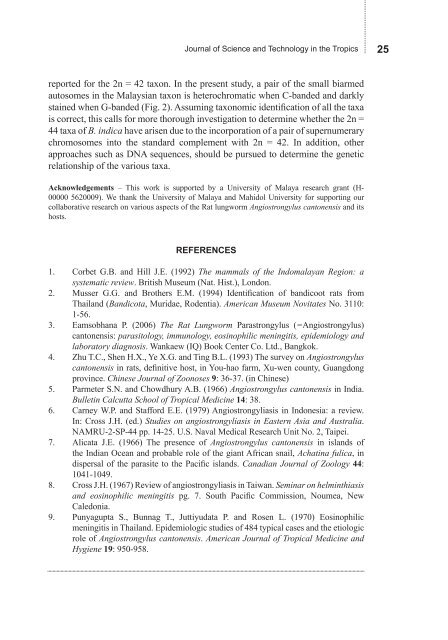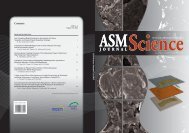Download - Akademi Sains Malaysia
Download - Akademi Sains Malaysia
Download - Akademi Sains Malaysia
You also want an ePaper? Increase the reach of your titles
YUMPU automatically turns print PDFs into web optimized ePapers that Google loves.
Journal of Science and Technology in the Tropics 25<br />
reported for the 2n = 42 taxon. In the present study, a pair of the small biarmed<br />
autosomes in the <strong>Malaysia</strong>n taxon is heterochromatic when C-banded and darkly<br />
stained when G-banded (Fig. 2). Assuming taxonomic identification of all the taxa<br />
is correct, this calls for more thorough investigation to determine whether the 2n =<br />
44 taxa of B. indica have arisen due to the incorporation of a pair of supernumerary<br />
chromosomes into the standard complement with 2n = 42. In addition, other<br />
approaches such as DNA sequences, should be pursued to determine the genetic<br />
relationship of the various taxa.<br />
Acknowledgements – This work is supported by a University of Malaya research grant (H-<br />
00000 5620009). We thank the University of Malaya and Mahidol University for supporting our<br />
collaborative research on various aspects of the Rat lungworm Angiostrongylus cantonensis and its<br />
hosts.<br />
REFERENCES<br />
1. Corbet G.B. and Hill J.E. (1992) The mammals of the Indomalayan Region: a<br />
systematic review. British Museum (Nat. Hist.), London.<br />
2. Musser G.G. and Brothers E.M. (1994) Identification of bandicoot rats from<br />
Thailand (Bandicota, Muridae, Rodentia). American Museum Novitates No. 3110:<br />
1-56.<br />
3. Eamsobhana P. (2006) The Rat Lungworm Parastrongylus (=Angiostrongylus)<br />
cantonensis: parasitology, immunology, eosinophilic meningitis, epidemiology and<br />
laboratory diagnosis. Wankaew (IQ) Book Center Co. Ltd., Bangkok.<br />
4. Zhu T.C., Shen H.X., Ye X.G. and Ting B.L. (1993) The survey on Angiostrongylus<br />
cantonensis in rats, definitive host, in You-hao farm, Xu-wen county, Guangdong<br />
province. Chinese Journal of Zoonoses 9: 36-37. (in Chinese)<br />
5. Parmeter S.N. and Chowdhury A.B. (1966) Angiostrongylus cantonensis in India.<br />
Bulletin Calcutta School of Tropical Medicine 14: 38.<br />
6. Carney W.P. and Stafford E.E. (1979) Angiostrongyliasis in Indonesia: a review.<br />
In: Cross J.H. (ed.) Studies on angiostrongyliasis in Eastern Asia and Australia.<br />
NAMRU-2-SP-44 pp. 14-25. U.S. Naval Medical Research Unit No. 2, Taipei.<br />
7. Alicata J.E. (1966) The presence of Angiostrongylus cantonensis in islands of<br />
the Indian Ocean and probable role of the giant African snail, Achatina fulica, in<br />
dispersal of the parasite to the Pacific islands. Canadian Journal of Zoology 44:<br />
1041-1049.<br />
8. Cross J.H. (1967) Review of angiostrongyliasis in Taiwan. Seminar on helminthiasis<br />
and eosinophilic meningitis pg. 7. South Pacific Commission, Noumea, New<br />
Caledonia.<br />
9. Punyagupta S., Bunnag T., Juttiyudata P. and Rosen L. (1970) Eosinophilic<br />
meningitis in Thailand. Epidemiologic studies of 484 typical cases and the etiologic<br />
role of Angiostrongylus cantonensis. American Journal of Tropical Medicine and<br />
Hygiene 19: 950-958.

















